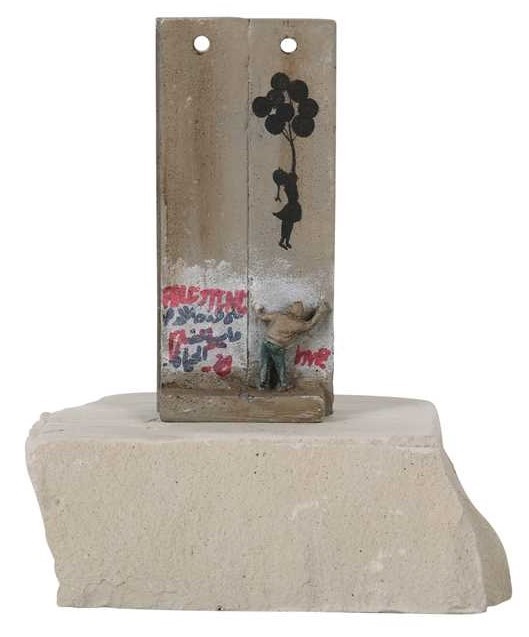

Prints and multiples are original artworks made in editions. Created through mechanical or digital processes, these pieces are not reproductions, but unique works produced intentionally in a limited series. Each piece in an edition carries artistic value and is often created, signed or authorised by the artist. Unlike copies of pre-existing works, prints and multiples are designed from the outset to be part of a cohesive edition.
Artists from Albrecht Dürer and Pablo Picasso to Banksy and Bridget Riley have used printmaking to explore their artistic vision, often producing some of their most recognised and accessible work in this medium. Multiples can include not just paper-based prints but also limited edition objects such as sculpture, ceramics, skateboards and even textiles.

BANKSY (BRITISH B.1974)
Wall Sculpture (Girl with Balloons)
Prints are created using several distinct processes. Here are the four key categories:
This method involves incising an image into a metal plate, which is then inked. The recessed lines hold the ink, and when paper is pressed onto the plate, the design is transferred.
PABLO PICASSO (SPANISH 1881-1973)
Le Repos du Sculpteur IV (Bloch 174)
In relief printing, the raised parts of a block (often wood or linoleum) form the image. These are inked and pressed onto paper, while the recessed areas remain blank.
ALBRECHT ALTDORFER (REGENSBURG 1480-1538)
Fall and Redemption, c. 1515
This technique uses a flat surface to create the print. The most common example is lithography, where the natural repulsion between oil and water is used to transfer an image.
Screenprinting became iconic through Pop Artists like Andy Warhol. Pochoir, often used in fashion illustration and decorative prints, involves hand-applied stencils to layer colour.
JOAN MIRO (SPANISH 1893-1983)
Les Voyants (Maeght 661)
BRIDGET RILEY CH CBE (BRITISH B.1931)
Sideways
The newest addition to printmaking, digital prints such as giclée or archival inkjet use high-quality printers to spray ink onto paper, often from a digitised original.
DAMIEN HIRST (BRITISH B.1965)
Fruitful (Large) [H8-21]
Most prints are signed and numbered by the artist. This indicates the print is part of a limited edition. An edition number such as 5/100 means this is the fifth print in an edition of one hundred. While the number within the run does not affect value, the overall edition size does. Smaller editions are more desirable and can command higher prices due to their rarity.
Signatures may also appear in different forms:
Hand-signed: Usually in pencil by the artist
Plate-signed: The artist's signature is part of the plate or matrix
Stamp-signed: Common in editions by Picasso and Warhol
LAURENCE STEPHEN LOWRY RBA RA (BRITISH 1887-1976)
The Cart
Edition sizes can vary greatly, with the limited number of works ranging from small runs of 10 through to large editions of 1000. The size of an edition is typically denoted as a fraction (1/300), or it may have an inscription to indicate it is a proof. Whether you have the first or last number of the edition the value is the same. As a rule of thumb value increases with smaller editions, as the print will be rarer and harder to acquire.
YAYOI KUSAMA (JAPANESE B.1929)
Pumpkins
AP (Artist’s Proof): Usually kept or gifted by the artist. May be numbered.
PP (Printer’s Proof): Retained by the printer or studio.
TP (Trial Proof): Used to test composition or colour before the final edition.
HC (Hors Commerce): Not for general sale, often used internally.
BAT (Bon à tirer): Final approved proof used to guide the edition.
Open Edition: No set limit on number produced.
Paper Types also affect value and appearance:
Wove paper: Smooth and commonly used
Laid paper: Textured with visible lines, typical in older prints
Handmade or Japanese paper: Long fibres, varied surface and fine quality
Prints are an excellent entry point into collecting art. They offer the opportunity to own a work by a celebrated artist at a more accessible price point. Whether you are starting a collection or adding depth to an existing one, prints and multiples provide a diverse, vibrant and often highly collectible area of the art market.
At Chiswick Auctions, our dedicated Prints and Multiples department specialises in 20th and 21st-century artworks. We regularly offer works by celebrated names including Barbara Hepworth, Joan Miró, Andy Warhol, Tracey Emin and Takashi Murakami.
Interested in the value of your prints or multiples?
Get in touch with our Prints and Multiples department for a complimentary valuation or submit an Online Valuation. We welcome enquiries from seasoned collectors and first-time sellers alike.